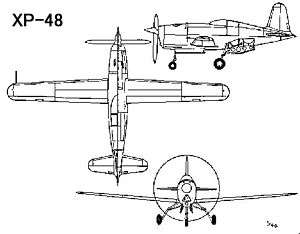Douglas XP-48
| XP-48 | |
|---|---|
 | |
| Role | Fighter aircraft |
| National origin | United States |
| Manufacturer | Douglas Aircraft Company |
| Status | Cancelled 1940 |
| Primary user | United States Army Air Corps |
| Number built | None |
|
| |
The Douglas XP-48 was a small, lightweight fighter aircraft, designed by Douglas Aircraft in 1939 for evaluation by the U.S. Army Air Corps. Intended to be powered by a small inline piston engine, the contract was cancelled before a prototype could be constructed, due to the Army's concerns about the projected performance of the aircraft.[1]
Inspiration
In the years before the outbreak of World War II, a number of countries became intrigued by the idea of developing a very light fighter aircraft,[2] with these proposals often being derived from the design of racing aircraft. Following the consideration of a modified French Caudron racer by the U.S. Army Air Corps, a proposition that was considered uneconomical,[2] Douglas Aircraft made an unsolicited proposal to the Army Air Corps of their Model 312 design in 1939.[2]
Design and cancellation
Intended to be powered by a Ranger XV-770 inverted V-12 engine equipped with a supercharger, Douglas' proposal was considered worth pursuing by the Army Air Corps, and on 5 August 1939 a single prototype was ordered. The Model 312 was given the Army designation XP-48, the 48th aircraft type in the Pursuit category.[3]
Closely resembling the later Bell XP-77,[4] the design of the XP-48 featured a wing of remarkably high aspect ratio, and was equipped with a pair of synchronized machine guns for armament,[3] Douglas touted the XP-48 as offering outstanding performance, with a top speed of at least 350 miles per hour (560 km/h),[3] and, according to Douglas' estimates, possibly as high as 525 miles per hour (845 km/h).[5]
However, this very aspect of its design was regarded with suspicion by the Army Air Corps.[3] The Ranger engine was suffering from development difficulties and delays and would never prove truly reliable.[6] At the same time, Douglas' performance estimates became increasingly regarded as being over-optimistic.[7] Accordingly, in February 1940 the Army cancelled the XP-48 contract,[3] and without government funding Douglas ceased development of the aircraft.[5]
Specifications (XP-48)
General characteristics
- Crew: one (pilot)
- Length: 21 ft 9 in (6.63 m)
- Wingspan: 32 ft (9.8 m)
- Height: 9 ft (2.7 m)
- Wing area: 92 sq ft (8.5 m2)
- Empty weight: 2,675 lb (1,213 kg)
- Gross weight: 3,400 lb (1,542 kg)
- Fuel capacity: 50 US gallons (190 l; 42 imp gal)
- Powerplant: 1 × Ranger SGV-770 inverted V-12 liquid-cooled piston engine, 525 hp (391 kW)
- Propellers: 3-bladed, 9.5 ft (2.9 m) diameter
Performance
- Maximum speed: 350 mph (563 km/h; 304 kn)
Armament
- Guns: 1 .30-caliber and 1 .50-caliber machine guns.
See also
- Aircraft of comparable role, configuration and era
- Related lists
References
Citations
- ↑ "Douglas XP-48". National Museum of the United States Air Force. Accessed May 9, 2010.
- 1 2 3 Norton 2008, p. 156
- 1 2 3 4 5 Norton 2008, p. 157
- ↑ AAHS Journal, Volume 28, Number 2. Summer 1983. American Aviation Historical Society
- 1 2 3 Angelucci 1987, p. 183.
- ↑ Adcock 1991, p. 45
- ↑ Brown et al. 1961, p. 64
- ↑ Francillon 1979
Bibliography
- Adcock, Al. OS2U Kingfisher in action. Carrollton, Texas: Squadron/Signal Publications, 1991. ISBN 0-89747-270-5.
- Angelucci, Enzo. The American Fighter from 1917 to the present. New York: Orion, 1987. ISBN 0-517-56588-9.
- Brown, Kimbrough et al. U.S. Army and Air Force Fighters, 1916-1961. Letchworth, UK: Harleyford Publications, 1961. ASIN B001YTWMPC
- Francillon, René J. McDonnell Douglas Aircraft since 1920. London: Putnam & Company Ltd., 1979. ISBN 0-370-00050-1.
- Norton, Bill. U.S. Experimental & Prototype Aircraft Projects: Fighters 1939–1945. North Branch, Minnesota: Specialty Press, 2008. ISBN 978-1-58007-109-3.
External links
| Wikimedia Commons has media related to Douglas XP-48. |